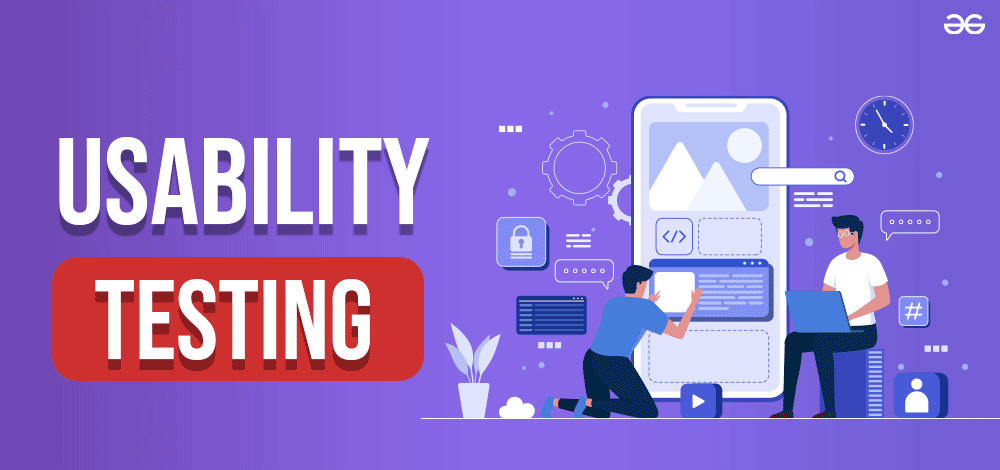If you’re a UX designer you must have encountered this term called “Usability Testing” or might also have been a part of a few in your company. Usability testing is a vital part of the UX Design Process, as it allows designers to verify and understand how the product is performing within a set of users that they are primarily targeting. This method helps identify usability issues, gather user feedback, and make informed design decisions as well as aims to uncover how easily users can accomplish tasks, navigate the interface, and find information.
As a UX designer to build a strong and user-centered product, you must have a thorough understanding of how actual consumers interact with your website or application.
What is Usability Testing?
Usability testing is an approach of researching where the intent is to learn about – “How is the product working when used by the actual users”, “What are the pros/cons of the product”, “Is the user able to understand and interact with the product” and etc. The main purpose of carrying out usability testing is to observe and know about the product between its end users.
Usability Testing is carried out based on the following objective, such as:
1. To gain insights about the user between its end user
The primary goal of usability testing is to understand and validate the solution that you’re proposing to the end user. This way you as a designer can effectively notice pain points and key requirements of the user which they want to be served by the solution. The data gathered by the insights can be both qualitative and quantitative as well. Based on how much time it is taking for a user to respond, the level of user satisfaction at the end of the task completion is something to be noticed.
2. To know about key features to meet the requirements
Usability testing plays a crucial role in gathering valuable insights from users. By observing real users while they interact with the system, the designer or usability test moderator can identify which features are most important and impactful in meeting user requirements. Through usability testing, one can directly observe how users interact with different features and gather feedback on their usability and effectiveness.
3. To know how users are interacting with the product
To know how the end users are interacting, here the process of usability testing gives insights into the behavior and interaction patterns of the user. This piece of information can be very important for a designer to refine the screen as per the user’s mental models and their actual needs.
4. To know what pain points the users have
Usability helps researchers and designers to know about the major pain points which a user encountered during their interaction with the product. Issues like complex navigation or confusing content can be easily detected through a thorough usability test. Not just the problems, it helps figure out ways in which the screen/product can be redesigned.
Now that we have some good ideas about what usability testing is, let’s look into the type of usability test questions that a researcher or designer, or usability analyst would ask a user while trying to validate the product.
Basically, there is usability documentation that is created by the researcher or the usability analyst in order to carry out the usability test smoothly. It helps them to prepare well for the particular problem statement to which they are trying to find answers. This document generally contains all the important information like:
- Test Objective: Why are we conducting the usability test?
- Participant Profile: Characteristics and demographics of the participants involved in the test, including age, gender, experience level, or any specific criteria relevant to the product or target audience.
- Test Tasks: List of tasks participants will be asked to perform during the test.
- Test Environment: The environment and setup required for conducting the usability test.
- Test Methodology: The methodology or approach used to conduct the usability test.
- Metrics and Measures: The metrics and measures that will be used to evaluate the usability of the product.
- Test Protocol: Step-by-step process that will be followed during the usability test.
- Ethical Considerations: Including NDA, permission forms, etc which would protect confidential information.
For a researcher to give the summary by collating all the best insights, helps designers to take quick action based on the facts. The specific content and structure of a usability test document may vary depending on the organization, project, and specific requirements. But it’s good to have a document ready before jumping into the actual test.
Now let’s look into the types of questions generally asked during a usability test session.
Types of Usability Test Questions
A researcher thoroughly understands the requirement and problem statement which a designer is trying to solve using the right set of user input. There are multiple variants or designs provided to the researcher in order to carry out the usability test.
Before starting the UT, research provides an NDA form to the users to avoid any data or information leak before the actual launch. Post-signing that, once the user is onboarded to the test session, it’s time to shoot the questions.
There are basically 3 types of usability test questions, such as:
1. The Ice-Breaker Questions
The main purpose of having the icebreaker questions is to make the participant comfortable. These questions help in gathering background data about the users participating in the testing session. A good set of icebreaker questions can help set up a good rapport between the moderator and the user. The idea is to keep things at a neutral pace such that the user doesn’t get too comfortable as well as not too nervous before going into the actual test questions. Ice breakers are also called “Pre-Testing Questions”
You as a moderator can focus on the following topics to prepare icebreaker questions around:
- User Demographics
- Name
- The city they are from
- Language in which they are comfortable to participate
- What do they feel about the existing version of the app?
- What user expects from the app?
To get an idea, here is a list of a few questions which you as a moderator can use to gather your user’s background information and make them feel normal before starting the actual test questions.
- Can you share a bit about yourself and your background?
- What are your experiences using [XYZ] applications?
- What are your expectations when it comes to using similar products or websites?
- Probe 1: What applications fall under the same genre you use?
- Probe 2: What do you think about those apps?
- Probe 3: Do they fulfill your expectations?
- Is there anything specific you hope to achieve or learn from this usability test?
- What features or aspects do you consider most important in a [product/website] like this?
- Do you have any concerns or questions before we begin?
2. The Real-Player Questions
The main objective of these questions is to provide the user with a chance to interact with your product while identifying any potential pain points. The right set of questions targeted to the problem statements lets the moderator know about what is working and what can be updated or revamped in such a way that the majority of users describe it. These are also called “Testing Questions”
You as a moderator should really keep an eye on the aspects where you can figure out points like:
- Where users are engaging and where they are disengaging?
- What parts are causing difficulty for the user?
- Which parts can be improved such that they can enhance the experience?
To get an idea, here is a list of a few questions which you as a moderator can observe user behavior, motivation, and enhancement points:
- What are your first impressions of the [product/website]?
- What about the look and feel of the [product/website]?
- Can you walk me through your thought process as you complete this task?
- Were there any aspects of the [product/website] that confused you or were difficult to understand?
- What do you think about the navigation of the app?
- Were there any features or functionalities that you found particularly useful or enjoyable?
- If you could change or improve one thing about this [product/website], what would it be?
3. The After-Effect Questions
The aim of these questions is to get consolidated opinions on the whole user experience based on the maximum number of users. A moderator should be able to thoroughly assess how well each activity performed when connected to one another to create a seamless and coherent experience using the post-testing questions. The most important thing about the post-test questions is to focus on what the user is doing or not on what the user says. Observing users is the key here. These are also called “Post-Testing Questions”
These questions at the end of the test give a clear picture of the following things:
- Overall user experience based on the majority of answers
- User impression on which variant is most liked and most fulfilling.
You as a moderator should really observe points like:
- How users are feeling about the app?
- How users have performed the tasks, irrespective of what they say?
To get an idea, here is a list of a few questions which you as a moderator can observe user behavior, motivation, and enhancement points:
- Can you please share your experience of this test session?
- Overall, how would you rate your experience using the [product/website]?
- What were the most challenging aspects of using the [product/website] during this test?
- Were there any unexpected or surprising findings during the test that you’d like to highlight?
- Do you have any suggestions or recommendations for improving the usability or user experience of the [product/website]?
- Is there anything else you would like to add or any additional feedback you’d like to provide?
- Is there anything you want to share based on your experience so far?
Must Check:
Conclusion
It is true to say that usability testing is a very powerful tool that a designer can use to mend design such that it does justice to the user-centric approach. Usability with complete context about the problem and full preparation not only helps to find issues but it’s one of the most effective ways to learn how actual users interact with your website or application.
So it’s a wrap for this article. If you’re a beginner who is keen to know about user research and usability testing, We hope you find this article helpful.
FAQs on Usability Testing
1. What is usability testing in UX design, and why is it important?
Usability testing in UX design is simply about watching real people try out a product to see if it’s easy to use and meets their needs. It’s essential because it helps designers find and fix any issues, making sure the final product is user-friendly and enjoyable to use.
2. How can usability testing help identify and address user experience issues in a product or service?
Usability testing helps us to find out what users like or dislike about a product and what gives them a hard time. It pinpoints issues and frustrations users might face so that the designers can fix them and make the product better and more user-friendly.
3. What are the different methods and techniques used in usability testing?
In usability testing, different methods and techniques are used to understand how users interact with a product. This includes moderated and unmoderated testing, thinking aloud, prototype testing, A/B testing, and remote testing. These methods help designers to gather valuable feedback and insights in order to improve the overall user experience.





